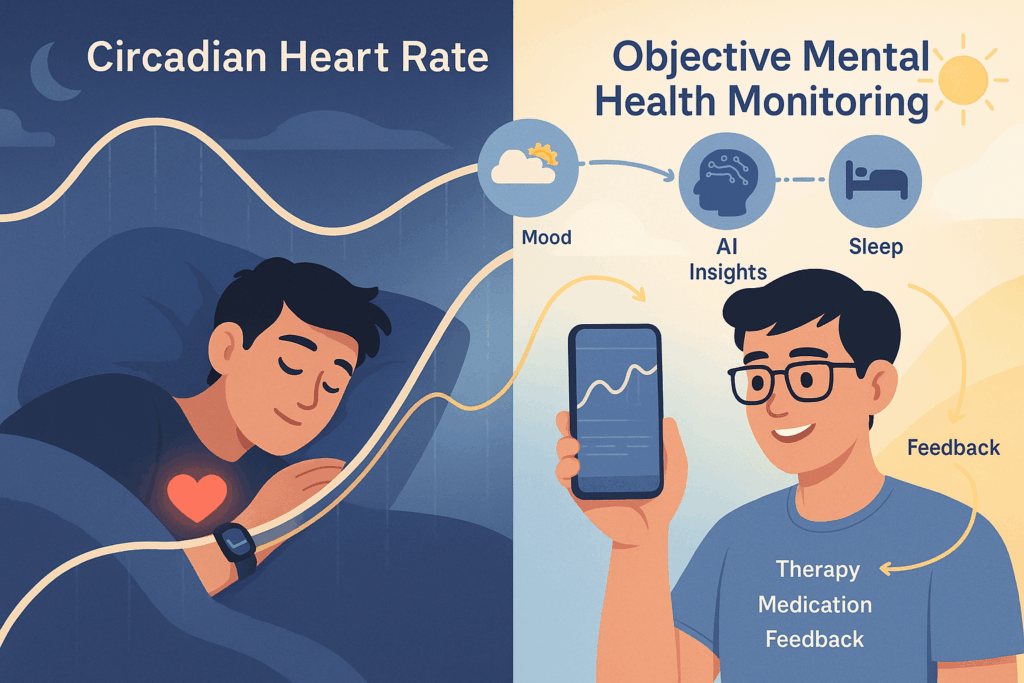Monitoring Mental Health Treatment Efficacy Through Circadian Heart Rate Analysis

Mental health is a complex, deeply individual journey—and monitoring progress or treatment efficacy often relies on subjective self-reporting. But what if your body could provide objective insights into your mental wellness? Enter circadian heart rate (CHR) analysis, a promising frontier in using physiology to track and understand mental health treatment outcomes.
What Is Circadian Heart Rate Analysis?
Circadian heart rate refers to the natural 24-hour fluctuations in your resting heart rate, influenced by your internal biological clock, or circadian rhythm. In a healthy individual, resting heart rate tends to decrease at night, reaching its lowest point during sleep, and increases during the day as activity and stress levels rise.
With the rise of wearables and continuous health monitoring, it’s now possible to track heart rate trends over days and weeks. These long-term patterns—especially the daily rhythm and variability of heart rate—offer a rich source of data that can be analyzed to reflect your body’s physiological state.
Mental Health and the Autonomic Nervous System
Your heart rate is tightly regulated by your autonomic nervous system (ANS), which is also deeply affected by mental health conditions. Anxiety, depression, PTSD, and other mental health challenges can disrupt the balance between the sympathetic (“fight or flight”) and parasympathetic (“rest and digest”) systems.
These disruptions often manifest in:
- Increased resting heart rate
- Blunted circadian variability
- Delayed or shallow nighttime heart rate dips
- Increased heart rate variability (HRV) suppression
CHR analysis captures these changes, providing a non-invasive physiological signal that reflects your mental and emotional state over time.
CHR as a Tool for Monitoring Treatment Response
When someone begins therapy, medication, lifestyle changes, or other interventions for mental health, tracking traditional symptoms like mood, sleep, or energy levels is important—but these are subjective. CHR analysis adds a continuous, objective layer of insight that can help:
1. Detect Physiological Improvements
For individuals undergoing treatment for depression or anxiety, improvements may be reflected in a more pronounced nighttime heart rate dip, or a return to a more stable circadian rhythm. These changes can occur even before the individual consciously feels better, offering early evidence of treatment efficacy.
2. Identify Non-Responders Early
If a person’s CHR pattern remains dysregulated weeks into treatment, it may suggest a need to adjust the treatment plan. This could reduce the typical “wait-and-see” period and accelerate time to effective care.
3. Monitor Medication Side Effects
Certain psychiatric medications can affect heart rate and rhythm. Tracking CHR can help clinicians determine whether side effects are disrupting circadian patterns, potentially guiding dosage adjustments.
4. Provide Real-Time Feedback
For those using cognitive behavioral therapy (CBT), mindfulness, or biofeedback techniques, CHR data can offer immediate feedback on physiological changes—reinforcing motivation and adherence.
The Role of Wearables and AI
Wearables like smartwatches and fitness bands can collect the continuous heart rate data needed for CHR analysis. When combined with AI algorithms, this data can be transformed into personalized insights, flagging when someone’s physiology is trending in a positive or negative direction.
Some platforms are now integrating CHR data with mood tracking and sleep analytics to offer a 360-degree view of mental health. This fusion of subjective and objective data is a powerful way to support more personalized and precise mental health care.
Challenges and Ethical Considerations
Despite its promise, CHR analysis isn’t a standalone diagnostic tool. It should be used alongside traditional clinical assessments. Key challenges include:
- Data privacy and ensuring secure handling of sensitive physiological data
- Interpreting variability, as heart rate is influenced by many factors (e.g., illness, alcohol, caffeine, exercise)
- Avoiding over-reliance on biometrics at the expense of human context
Still, as research deepens and algorithms improve, CHR has the potential to become a valuable biomarker for mental health monitoring.
Conclusion
Circadian heart rate analysis bridges the gap between mind and body, offering a passive, continuous way to monitor the physiological effects of mental health treatments. By turning everyday heart rate data into actionable insights, we move closer to a future where mental wellness is tracked and supported with the same rigor and real-time feedback as physical fitness.
